Recent development of pillar[n]arene-based amphiphiles
2021-10-14YanCaiZhechengZhangYueDingLanpingHuJinWangTingtingChenYongYao
Yan Cai,Zhecheng Zhang,Yue Ding,Lanping Hu,Jin Wang*,Tingting Chen*,Yong Yao*
School of Chemistry and Chemical Engineering, Nantong University, Nantong 226019, China
1 These authors contributed equally to this work.
ABSTRACT Pillar[n]arene-based amphiphiles, mainly including amphiphilic pillar[n]arenes and supra-amphiphilic pillar[n]arenes, have obtained considerable interests in recent years due to their fascinating chemical structures, various self-assembly behaviors, and widely applications.Thanks to the pillar-like frameworks and the rich host-guest recognitions of the cavities, these amphiphiles can be easily controlled to form dimensional and morphologic assemblies for multiple applications.Compared with traditional linear covalent amphiphiles, the introduction of host-guest recognitions facilitated the preparation and controllability of these supramolecular amphiphilic systems.Moreover,the host-guest recognitions endow the assemblies from pillar[n]arene-based amphiphiles with stimuli-responsive functions.In this mini-review,we summarized the chemical structures,self-assembly features,and the applications of pillar[n]arene-based amphiphiles.However, several research topics of pillar[n]arenebased amphiphiles can be further developed in the future, such as larger cavity amphiphilic pillar[n]arenes, co-assembly with 2D materials and utilization of the host-guest interactions.
Keywords:Pillar[5]arene Supramolecular assemblies Amphiphiles Reversible conversion Controlled release
1.Introduction
Amphiphiles are a class of fascinating molecules which possess both hydrophilic and hydrophobic units connected by covalent bonds [1].When amphiphiles dispersed in aqueous solution, the hydrophobic part tends to stay in the gas/liquid interface while the hydrophilic part interacts with aqueous phase.So in this way,amphiphiles can self-assemble into various nano-structures in water [2].For example, phospholipids, a traditional type of amphiphile in the living system,usually self-assembly into bilayer biological membranes through hydrophilic-hydrophobic interactions [3].Inspired by nature, scientists designed and prepared various synthetic amphiphiles and ultilized them to construct various well-defined structures in water,such as spherical micelles and vesicles, 2D nanofibers, nanotubes [4].What is more, the morphology of the assemblies can be controlled by tuning the experimental conditions such as temperature, concentration, pH and ionic strength[5].Until now,the assemblies from amphiphiles have been widely applied in many areas,especially in drug delivery and cell imaging [6].
Supramolecular chemistry is a new interdiscipline, it mainly investigated the ordered assemblies constructed from simple building blocks and the interactions(including hydrogen bonding,hydrophilic -hydrophobic interactions and π-π stacking)between each building block[7].By connecting amphiphiles and supramolecular chemistry, supramolecular amphiphiles possess both advantages of amphiphiles and supramolecular chemistry; have attracted tremendous interests of scientists [8].Compared with traditional covalent amphiphiles,various functional groups can be modified on supra-amphiphiles by noncovalent interactions,greatly avoiding tedious organic syntheses [9].Moreover, the dynamic and reversible nature of noncovalent interactions endows the resultant supramolecular architectures with rich stimuliresponsiveness [10].
Pillar[n]arenes, the fifth generation of macrocyclic hosts,composed of hydroquinone (or its derivatives) connected by CH2at their 2,5-position, have attracted considerable interests due to their unique symmetric pillar-shaped framework and electrondonating cavities [11].Pillar[n]arenes have 2n sites for derivation and their sizes can be adjusted.Until now, the preparation,derivatization, host-guest properties, self-assembly features in different solvents, and applications of pillar[n]arenes have been widely investigated[12].Compared with crown ethers and calixar[n]arenes, pillar[n]arenes possess a more rigid structure, which made a large number of guest molecules suitable for pillar[n]-arenes.On the other hand,the preparation and functionalization of pillar[n]arenes is easier than cyclodextrins and cucurbiturils [13].With these advantages, pillar[n]arenes have been described as “a new class of macrocycles for supramolecular chemistry ”and have been widely used to fabricate amphiphiles and supra-amphiphiles[14].
Although we have published a review about amphiphilic pillar-[n]arenes[15],supra-amphiphilic pillar[n]arenes were not included.Additionally, more and more scholars contribute to the development of pillar[n]arene-based amphiphiles.In this review,we summarize both amphiphilic pillar[n]arenes and supraamphiphilic pillar[n]arenes reported up to now and focus on their novel molecular structures, controllable self-assembled morphologies and behaviors, multiple stimuli-responsiveness, functional materials and biomedical applications.
2.Amphiphilic pillar[n]arenes
2.1.Chemical structures of amphiphilic pillar[n]arenes
Pillar[n]arenes possess 2n sites which are easily modified,as a result,different type of amphiphilic pillar[n]arenes were obtained by simply functionalized hydrophilic or hydrophobic units on the frameworks.Amphiphilic pillar[n]arenes can be classified into four classical types according to hydrophilic and hydrophobic groups decorated on different positions: (a) rim-differentiated amphiphilic pillar[n]arenes;(b)gemini-type amphiphilic pillar[n]arenes;(c) Bola-type amphiphilic pillar[n]arenes; (d) mono-modified amphiphilic pillar[n]arenes (Scheme 1).We comprehensively list these four classes of amphiphilic pillar[n]arenes reported up to now in Schemes 2-5 in order to facilitate readers to following this field and further studies.
As we can see from the schemes,almost all amphiphilic pillar[n]arenes are based on pillar[5]arene.There is just one example about amphiphilic pillar[6]arene, and no amphiphilic pillar[n]arene based on larger cavity.For rim-differentiated amphiphilic pillar-[5]arenes,alkyl chains with different length as hydrophobic units located on one rim of the framework,amino groups,PEG groups,or carboxylate groups as hydrophilic groups located on the another rim of the framework (Scheme 2) [ 16-25].For example, the first amphiphilic pillar[5]arene 1 with N-(2-aminoethyl)acetamide as hydrophilic part and pentyl as hydrophobic tail prepared by Huang and co-workers is a typical rim-differentiated amphiphile[ 16-18].For Gemini-type amphiphilic pillar[5]arenes,they usually contain ten hydrophlic parts in the middle of the substitution on the both rims of the framework (Scheme 3).In order to prepare a Geminitype amphiphilic pillar[5]arene, a bromoalkyl modified pillar[5]-arene was synthesized first,then it reacted with trialkylphosphorus or trialkylamine to obtain the target product [26,27].On the other hand,for Bola-type amphiphilic pillar[5]arenes,they possess ten hydrophilic groups, such as amino groups, PEG chains and glycosyl parts,at the ends of the substitutions(Scheme 4)[20, 28-30].For mono-modified pillar[n]arenes(Scheme 5),usually a large hydrophilic group modified on hydrophobic pillar[5]arene(21)or a large hydrophobic group substitute on water-soluble pillar[5]arene(22,23)[ 31-33].In this case,the only one example of amphiphilic pillar[6]arene was prepared as mono-modified amphiphilic pillar-[n]arene (24) [34].
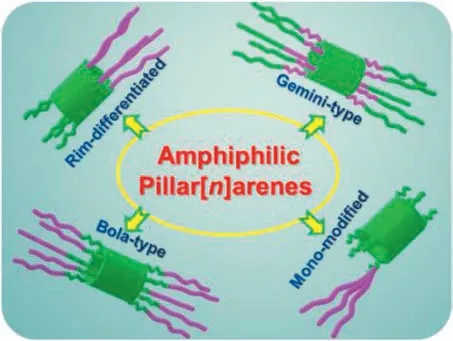
Scheme 1.Schematic illustration of various types of amphiphilic pillar[n]arenes.
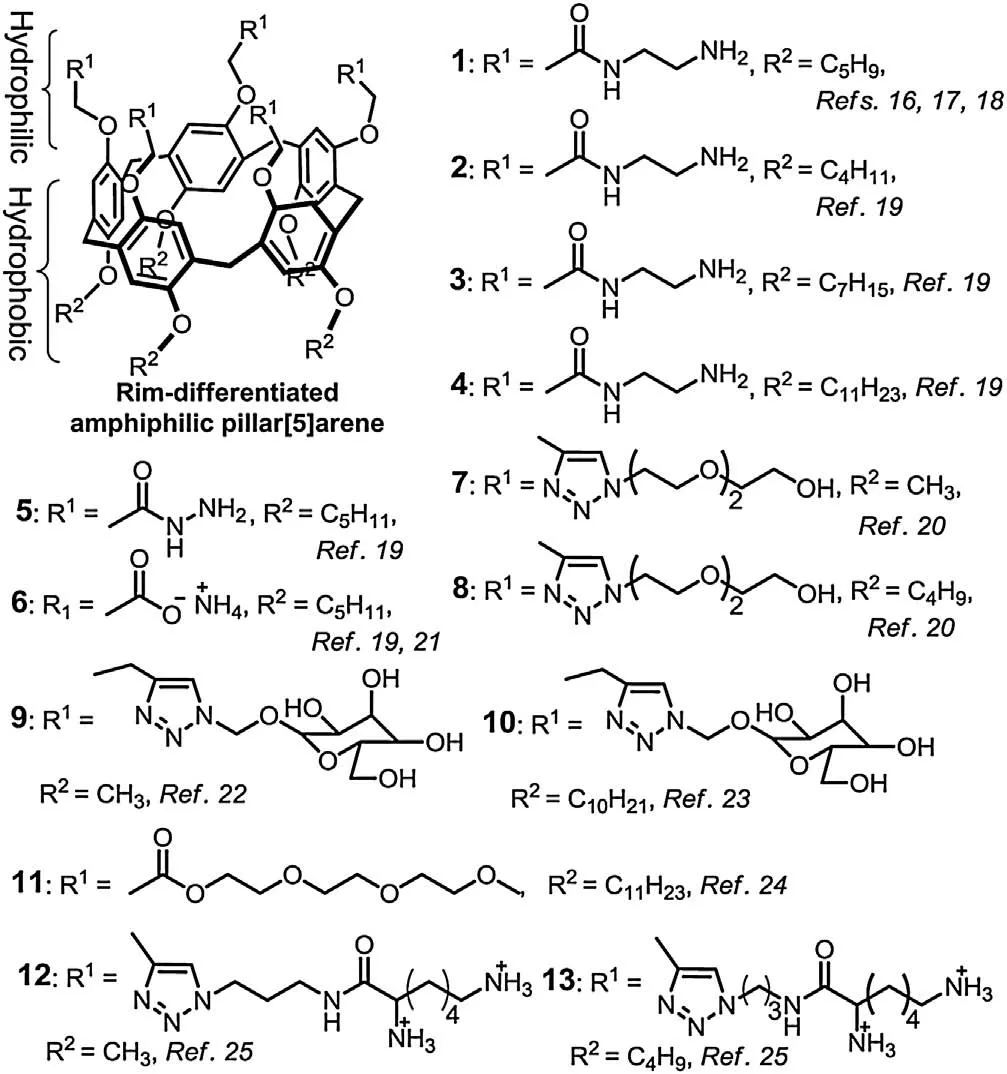
Scheme 2.Chemical structures of rim-differentiated amphiphilic pillar[n]arenes.
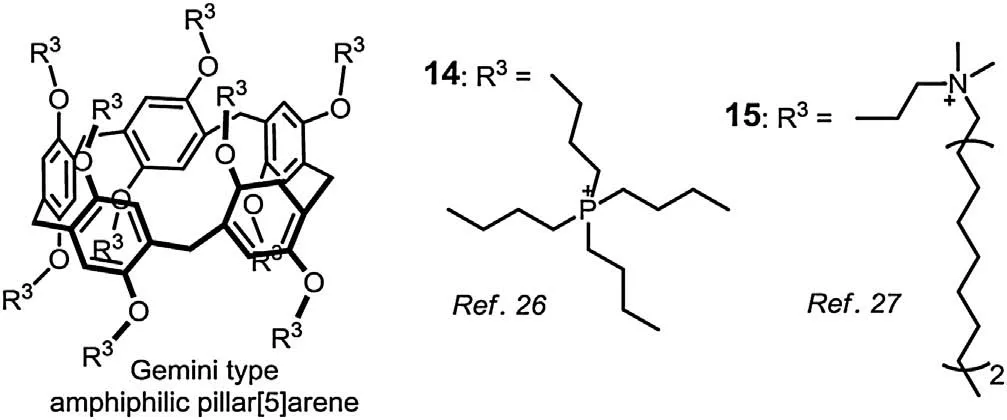
Scheme 3.Chemical structures of typical Gemini-type amphiphilic pillar[5]arenes.

Scheme 4.Chemical structures of typical Bola-type amphiphilic pillar[5]arenes.

Scheme 5.Chemical structures of mono-modified amphiphilic pillar[n]arenes.
2.2.Self-assembly properties of amphiphilic pillar[n]arenes
As a typical type of amphiphilic compounds,when amphiphilic pillar[n]arenes dispersed in aqueous solution, they can selfassembly into various dimensional nanostructures, such as micelles,vesicles,nanotubes,nanofibers and membranes,depending on different hydrophilic groups, self-assembly time, concentration [16].
2.2.1.Micelles
When the hydrophilic part of amphiphilic pillar[n]arene is very large, it usually self-assembly into micellar structures when dispersed in water with a concentration larger than critical aggregation concentration(CAC).For example,in 2015,Prof.Huang and co-workers synthesized a polyethyleneglycol-substituted amphiphilic pillar[5]arene (21), due to the large polyethyleneglycol unit, it can self-assembly into micelles when dissolved in water or aqueous phosphate buffer containing saline (PBS, pH 7.4,10 mmol/L) spontaneously [31].What is more, these micelles exhibit superior drug encapsulation capability, and display drug release behaviour in response to enzyme catalysis (Fig.1).
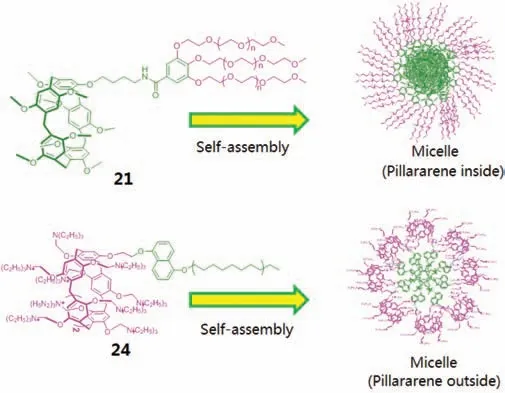
Fig.1.Schematic representation of the formation of solid micelle from monomodified amphiphilic pillar[5]arene 21 and 24.Reproduced with permission[31,34].Copyrights 2014 and 2015, the Royal Society of Chemistry.
Besides that, Prof.Diao and co-workers synthesized the first amphiphilic pillar[6]arene with mono-alkyl chain as the hydrophobic part and eleven trimethylamine salt as the hydrophilic part(24).Due to the large ratio of the hydrophilic/hydrophobic part,24 self-also assemble into micelles spontaneously when dispersed in water [34].Interestingly,Prof.Sakurai and co-workers prepared a new rim-differentiated amphiphilic pillar[5]arene 13 and investigated its self-assembly behaviour in water.Small angle X-ray scattering, field flow fluctuation coupled with multi-angle light scattering and atomic force microscopy measurements revealed that 13 forms a stable bimolecular micelle in which the alkyl tails face each other and the hydrophobic portions are entirely covered by the long hydrophilic groups [25].
2.2.2.Vesicles
However,when the hydrophilic part decreased to an appropriate value, amphiphilic pillar[n]arenes tend to self-assemble into vesicles instead of micelles.For example, Prof.Huang and coworkers found that when amphiphilic pillar[5]arene 1 dispersed in water,it tends to form vesicles in water.They further used dynamic light scattering (DLS), scanning electron microscopy (SEM), and transmission electron microscopy (TEM) to confirm that the diameter of the vesicles was about 200 nm,and the wall thickness of the vesicles was about 4 nm,indicating that the vesicles with a bilayer wall structure (Fig.2a) [16].Most of rim-differentiated amphiphilic pillar[5]arene, such as 2, 3, 4, 11 all tend to form bilayer vesicles [19].Besides, Prof.Pei and co-workers found that Bola-amphiphilic pillar[5]arene 19 with appropriate ratio of hydrophilic/hydrophobic value could self-assembly into mono layer vesicles in water(Fig.2b)[29].In our recent investigation,we prepared a new Gemini-type amphiphilic pillar[5]arene 15 and found it could self-assembly into multi-layer wall vesicles in water[27].

Fig.2.Schematic representation of the formation of(a)bilayer vesicle from 1,and(b) monolayer vesicle from 19.Reproduced with permission [29].Copyright 2014,John Wiley and Sons.
2.2.3.Tubes and other structures
When there are extra intermolecular interactions such as Hbonds or π-π stacking between amphiphilic pillar[n]arenes, the micelles or vesicles can further fuse together into higherdimensional nanotubes.For example, Huang and co-workers found that there are some floccules in the solution of vesicles formed by 1 after staying 2 weeks.What is more,the floccules were found to become consistently larger and darker as the incubation time increased.With the assistance of SEM,TEM,AFM and UV- vis spectroscopy, they confirmed that the floccules were in fact multilayer micro-tubes with an exterior diameter of about 1.2 μm,a thickness of about 200 nm, and an inner diameter of about 800 nm (Fig.3).This transformation is due to the existence of multiple intermolecular H-bonds[16].Then they found that sugar modified amphiphilic pillar[5]arene 9 can also assemble into nanotubes due to the weaker H-bonds between sugar molecules [24].
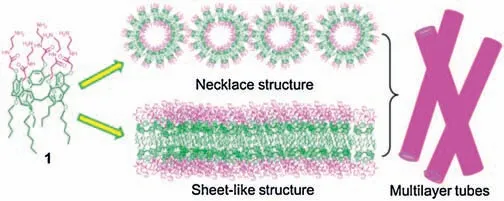
Fig.3.Schematic representation of the formation of multilayer tubes from amphiphilic pillar[5]arene 1.Reproduced with permission [16].Copyright 2012,American Chemical Society.
In 2015,Prof.Zhou and co-workers prepared a Bola-amphiphilic pillar[5]arene 18 with ten amino groups as the hydrophilic heads and ten amide unites to afford H-bonds.They found that when 18 were dissolved in water, the morphology of its assemblies transformed from vesicles to micelles with the decrease of pH.When the pH value was 5-7, the vesicles can further selfassemble into well-defined micro-tubes after 2 weeks.Additionally,the concentration of 18 has a huge influence on the assembly morphology.Only when the concentration was close to its CAC could it further self-assemble into micro-tubes.While under other concentrations, it only self-assembles into gel-like structures.However,when 18 was dissolved in THF first and then dropped into water,it self-assembled into micro-tubes immediately(Fig.4)[28].

Fig.4.Schematic representation of amphiphilic pillar[5]arene 18 self-assembly into various nanostructures.Reproduced with permission [28].Copyright 2015,American Chemical Society.
2.3.Application of amphiphilic pillar[n]arenes
The rapid development of amphiphilic pillar[n]arenes in these few years fully demonstrates their special charm.This charm is not only reflected in the perfect space structure and rich self-assembly properties of the amphiphilic pillar[n]arenes, but also in their applications in various fields.So far, the applications of amphiphilic pillar[n]arenes have covered catalysis, drug delivery, cell imaging and agglutination, and white-light-emitting.
2.3.1.Catalysis
In 2013, Prof.Huang and co-workers used amphiphilic pillar[5]arene 1 as the stabilizer to prepare water-soluble gold nanoparticles (1-AuNPs).They found that 1-AuNPs not only can decorate on the surfaces of the template multilayer tubes selfassembled from 1 to form template composite microtubes(TCMTs),but also can self-assembly into self-assembled composite microtubes (SCMTs) in water itself after about 1 month.Interestingly, SCMTs showed more stable at high temperature,with strong acid, with strong base, and under sonication than TCMTs.Due to the AuNPs incorporated in the composite microtubes, they can be used as catalyst to reduce 4-nitroaniline in the presence of NaBH4.The result showed that SCMTs are excellent catalysts and the yield loss within 3% even after 20 cycles (Fig.5)[17].Then in 2015, Prof.Zhou and co-workers used Bolaamphiphilic pillar[5]arene 18,which process the same hydrophilic groups like 1,to fabricate AuNPs doped microtubes(AuDMTs)and found that AuDMTs can be used as recycled catalysts for reduction of 4-nitrophenol by NaBH4[28].

Fig.5.Schematic representation of the two types of composite microtubes based on amphiphilic pillar[5]arene 1 as catalyst.Reproduced with permission [17].Copyright 2013, the Royal Society of Chemistry.
In addition, Ogoshi and co-workers synthesized an Geminiamphiphilic pillar[5]arene 14 consisting of ten tetra-alkyl phosphonium bromide groups, and used it applied in phase transfer catalysis with high efficiency and substrate selectivity.In particular,oxidation of the linear alkene1-hexene to 1-pentanal by KMnO4was > 99%, whereas that of the branched alkene 4-methyl-1-hexene was only 31%under the same conditions(Fig.6)[26].This selectivity phase transfer catalysis properties have not been observed in other phase transfer catalysts without pillar[5]arene framework.This study demonstrated the host-guest properties of pillar[5]arene contributed to the efficient and substrate-selective phase transfer catalysis properties.
2.3.2.Drug delivery and cancer therapy

Fig.6.Schematic representation of amphiphilic pillar[5]arene 14 as an efficient and substrate-selective phase-transfer catalyst.Reproduced with permission [26].Copyright 2013, American Chemical Society.
As we discussed above,when an amphiphilic pillar[n]arene was dispersed in aqueous solution,it can self-assembly into vesicles or micelles at the beginning.In this case,the vesicles or micelles can encapsulate drug molecules within their interior and release of encapsulated molecules upon an external stimulant.For example,in 2014,Prof.Pei and co-workers synthesized a novel ferrocenium modified amphiphilic pillar[5]arene 19 and found it can selfassemble into cationic vesicles in aqueous solution.The cationic vesicles,displaying low cytotoxicity and significant redox-responsive behavior due to the redox equilibrium between ferrocenium cations and ferrocenyl groups,allow building an ideal glutathione(GSH)-responsive drug/siRNA co-delivery system for rapid drug release and gene transfection in cancer cells in which higher GSH concentration exists [29].This is the first report of redoxresponsive vesicles assembled from pillar[n]arenes for drug/siRNA co-delivery; besides enhancing the bioavailability of drugs for cancer cells and reducing the adverse side effects for normal cells,these systems can also overcome the drug resistance of cancer cells(Fig.7).

Fig.7.Schematic representation of amphiphilic pillar[5]arene 19 self-assembly into cationic vesicles, and their redox-responsive drug/siRNA release.Reproduced with permission [29].Copyright 2014, John Wiley and Sons.
At the same year, Prof.Diao and co-workers constructed a magnetic-responsive drug delivery system based on amphiphilic pillar[5]arene(11)which contain five oligomeric glycol groups and five alkyl chains.11 spontaneously formed bilayer vesicles in water,and these vesicles were still stable after several weeks.Additionally, when they were exposed to external physical stimuli, these vesicles also showed reversible thermal and dynamic properties.Interestingly, oleic-acid-stabilized magnetic iron oxide nanoparticles could be incorporated into the bilayer of the 11-based vesicles to form hybrid magnetic-responsive supramolecular vesicles, and these hybrid vesicles could be used in magnetic controlled release (Fig.8) [24].

Fig.8.Schematic representation of amphiphilic pillar[5]arene 11 self-assembly into bilayer-vesicles, and further application in magnetic-responsive drug release.Reproduced with permission [24].Copyright 2014, American Chemical Society.
Then they also prepared the only amphiphilic pillar[6]arene 24 and found that free 24 can merely form a small micellar assembly,while ATP can induce its CAC decreases pronouncedly by over two orders of magnitude.Furthermore, the vesicles are efficiently responsive to alkaline phosphatase that triggers the vesicles to collapse via the hydrolysis of ATP[34].This transformation can be used to trigger the controlled release of encapsulated drug molecules.
In 2019, Prof.Zhang and co-workers reported a charge-reveral amphiphilic pillar[5]arene bearing ten charge-reversal headgroups(20).In the acidic tumor microenviroment, the headgroup charge of 20 reversed from negative to positive due to the hydrolysis of the acid-labible amide units.The hydrolyzed product from 20 contain multiple positive charges can bind to the cell membrane and then disrupt the membrane of cancer cells with high efficiency.In comparison,under the healthy cells ’neutral microenviroment,20 remains stable and the cytotoxicity is considerably reduced(Fig.9).This is a new strategy for cancer chemotherapy [30].
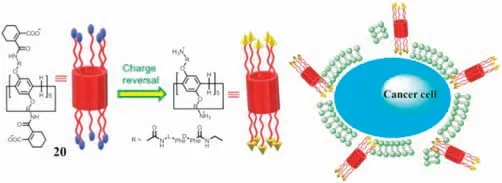
Fig.9.Schematic representation of charge-reversal amphiphilic pillar[5]arene for selective killing of cancer cells.Reproduced with permission[30].Copyright 2019,American Chemical Society.
Different like encapsulated drug molecules into the interior of vesicles or micelles,in 2018,Prof.Hu and co-workers synthesized a novel pillar[5]arene- based amphiphilic prodrug 23 and a tailormade RGD-sulfonate guest RGD-SG [33].They found that the morphologies of the self-assembled aggregates formed from the 23@RGD-SG depend on the molar ratio of 23: RGD-SG.The assemblies from 23@RGD-SG not only possessed high drugloading capacity, but also exhibited targeting ability as well as acid-responsive drug release.In vitro experiments showed that both types of nanocarriers preferentially deliver the anticancer drug DOX to RGD receptor overexpressing cancer cells.After internalization by cells via endocytosis,the hydrazine linkage was destroyed by the acidic endolysosomal environment,leading to the disassembly of the nanocarriers, accompanied by rapid drug release and efficient DOX accumulation in cancer cells.Therefore,the anticancer efficacy was maximized, while the side effects to normal tissues were obviously reduced relative to the free drug DOX (Fig.10).In vivo experiments further demonstrated the enhanced antitumor efficacy and reduced systematic toxicity of these prodrug nanocarriers in the murine tumor model.
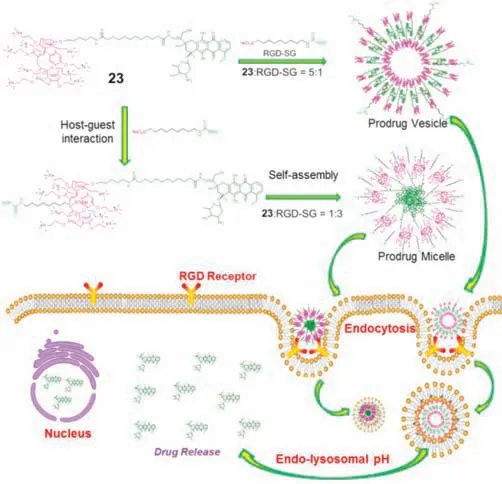
Fig.10.Schematic representation of amphiphilic pillar[5]arene 23 self-assembly into various nano-structures,and further application in pH-responsive drug release.Reproduced with permission [33].Copyright 2018, John Wiley and Sons.
2.3.3.Cell imaging and agglutination
Besides catalysis and drug release, Prof.Zhao and co-workers also applied amphiphilic pillar[5]arene in cell-imaging in 2013.A series of tadpole-like and Bola amphiphilic pillar[5]arenes 7,8,16,17 were synthesized by selectively employing water-soluble ethylene glycols and hydrophobic alkyl units as the starting materials.In comparison with their monomers,these amphiphilic pillararenes not only show improved biocompatibility to cells but also could form homogeneous supramolecular self-assemblies.Interestingly, different types of amphiphilic pillararene-based assemblies exhibit various performances on the delivery of dyes with different aqueous solubility.All assemblies can deliver watersoluble rhodamine B to cells, while only tadpole-like amphiphilic pillar[5]arene (7, 8)-based assemblies performed better on delivering hydrophobic fluorescein isothiocyanate for imaging.In addition, pillar[5]arene derivatives 7,16 and 17 could complex with a viologen guest, further forming stable assemblies for bioimaging.In such cases,the assembly formed from the complex of tadpole-like amphiphile pillar[5]arene 7 with the viologen guest performed better in delivering mixed dyes (Fig.11) [20].
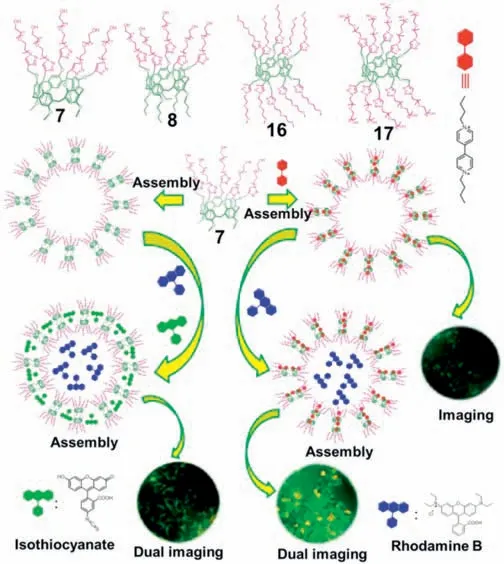
Fig.11.Schematic representation of self-assemblies of amphiphilic pillar[5]arenes as carriers for dual bio-imaging.Reproduced with permission[20].Copyright 2013,American Chemical Society.
In addition, Prof.Huang and co-workers also applied amphiphilic pillar[5]arene in cell agglutination.They designed a novel sugar-functionalized amphiphilic pillar[5]arene 10 with galactoses as the hydrophilic part and alkyl chains as the hydrophobic part.Due to the existence of intermolecular hydrogen bonds between the galactoses and the van der Waals interactions between the alkyl chains,10 self-assembled into vesicles in water and gradually transformed into nanotubes after standing for 1 week.The biocompatible galactoses coating the nanotubes endowed them with interesting biofunctions, which could act as excellent cell glues to effectively agglutinate E.coli [23].These results showed that supramolecular self-assemblies composed of rather simple ligands driven by noncovalent interactions are distinctive chemical tools for capturing living bacteria in solution.
2.3.4.White-light-emitting
In 2018, our groups designed and synthesized a new Geminitype amphiphilic pillar[5]arene 15, When 15 was dispersed in water, it could self-assemble into well-defined vesicles, and showed excellent surface activities as compared to other types of amphiphilic pillar[5]arene reported previously.Furthermore,15 can also induce hydrophobic molecules to dissolve in water because hydrophobic molecules can be encapsulated in the wall of the vesicles.Interestingly,white light emission was obtained with the assistance of two other guests CTPE and FL (Fig.12)[27].This work provides a white light emitting system based on a new amphiphilic pillar[5]arene with excellent surface activity.Such systems have many potential applications in our real life,such as in display technologies and optical sensing.

Fig.12.Schematic representation of amphiphilic 15 self-assembly into vesicles and application in white-light-emitting systems.Reproduced with permission [27].Copyright 2018, the Royal Society of Chemistry.
The assemblies from amphiphilic pillararenes are very stable,and they also contain the cavities of pillararenes,which can further complex guest molecules selectively.All these advantages made amphiphilic pillararenes applying in various areas.But how to prepare amphiphilic pillar[5]arenes efficiently and how to prepare amphiphilic pillar[n]arenes( n >5)are the two big problems which inhibit the further development of amphiphilic pillararenes.In this case, supra-amphiphilic pillar[n]arenes were constructed to resolve the above problems.
3.Supra-amphiphilic pillar[n]arenes
3.1.Chemical structures of supra-amphiphilic pillar[n]arenes
Pillar[n]arenes process cavities, which endow them with binding affinity to various guests.Specific to water soluble pillar[n]arenes, they interact with guests including dyes, drugs,and biomacromolecules by hydrophobic interactions, π-π interactions,and electrostatic interactions and so on.Furthermore,their unique skeletons provide multivalent interaction sites.
As a result, these guests efficiently affect the aggregation of amphiphilic pillar[n]arenes,and the aggregation behavior of these guests could be modulated by pillar[n]arenes conveniently [12a].Based on the charge the water soluble pillar[n]arenes possess,the supra-amphiphilic pillar[n]arenescan be divided into anionic water-soluble pillar[n]arene-based supra-amphiphiles (anionic-WPnSA), cationic water-soluble pillar[n]arene-based supraamphiphiles (cationic-WPnSA), and neutral water-soluble-pillar-[n]arene based supra-amphiphiles (neutral-WPnSA) (Scheme 6).
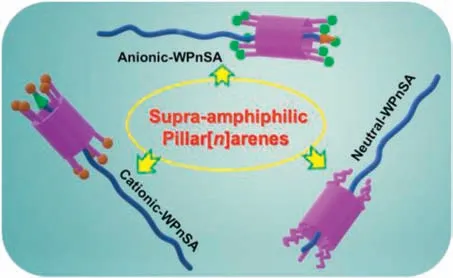
Scheme 6.Schematic illustration of various types of supra-amphiphilic pillar[n]arenes.
Anionic-WPnSA was constructed from anionic water-soluble pillar[n]arenes associated with cationic guests (Table 1) [35-62].The interaction with cationic guests reduces the solubility of anionic water-soluble pillar[n]arenes(AWPn),resulting in amphiphilic properties.Chemical structures of AWPn and guest molecules which have been used to construct anionic-WPnSA are summarized in Scheme 7.For example, Prof.Wang and coworkers used typical carboxylate modified water-soluble pillar[5]arenes (AWP5) and diphenylboronic acid derivatives 45 to construct a multiresponsive supramolecular amphiphile for integrated glucose sensing and insulin delivery[55].Following the same principle, cationic-WPnSA was prepared from cationic water-soluble pillar[n]arenes associated with anionic guests(Table 1)[63-66].Up to now,only three types of cationic-WPnSAs were constructed as shown in Scheme 8, and they were all about pillar[6]arene.For example,our group used imidazolium modified water-soluble pillar[6]arene (CWP6-3) and sodium benzoate derivative 56 to fabricate a new supramolecular amphiphile (SA-33).We found that SA-33 can self-assembly into vesicles in aqueous solution and showed pH responsive drug delivery [66].However, when neutral water-soluble units, such as glycol chain,selenyl group and glycosyl group, modified on the frame-work of pillar[n]arene,it can also complex with hydropobic guests to form neutral-WPnSA [67-72].For instant, Prof.Huang and co-workers used a selenium-containing pillar[5]arene (NWP5-1) and a pyridinium bromide salt (57) to constructe a supramolecular amphiphile with redox-responsiveness [67].Chemical structures of NWPn and possible guest molecules which have been used to construct neutral-WPnSA are summarized in Scheme 9.
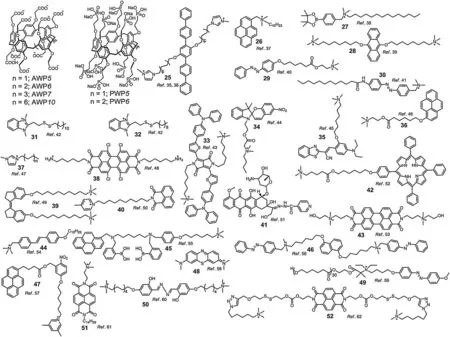
Scheme 7.Chemical structures of anionic water-soluble pillar[n]arenes and related guest molecules.
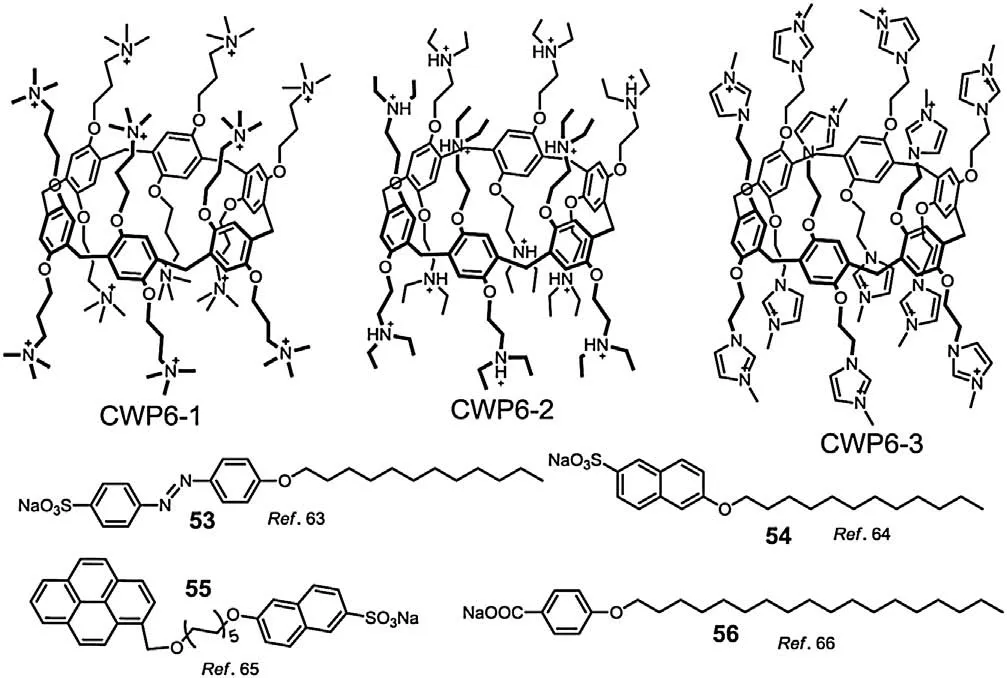
Scheme 8.Chemical structures of cationic water-soluble pillar[n]arenes and related guest molecules.

Scheme 9.Chemical structures of neutral water-soluble pillar[n]arenes and related guest molecules.
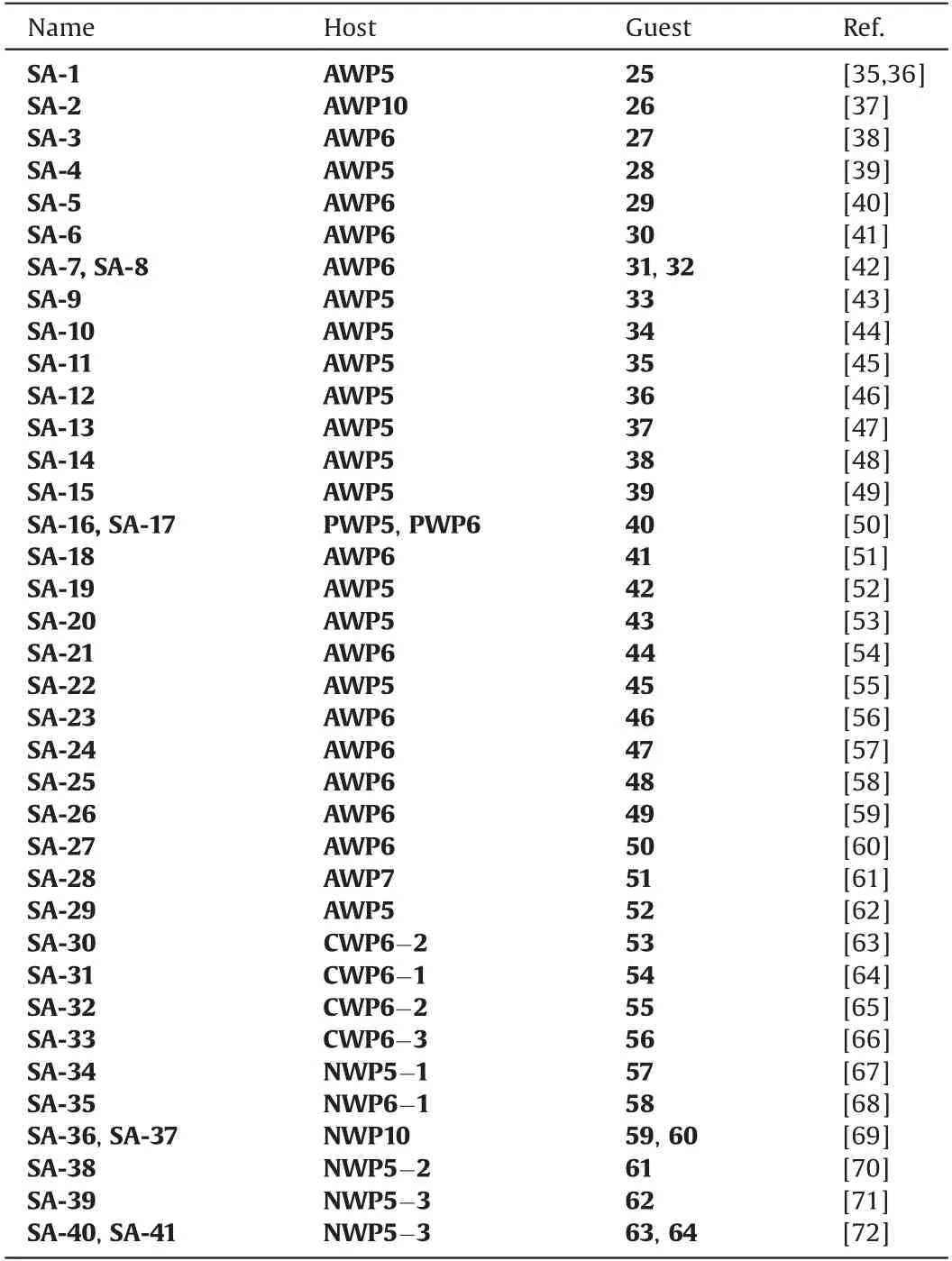
Table 1 Different building blocks for constructing pillar[n]arene-based supramolecular amphiphiles.
3.2. Self-assembly and applications of supra-amphiphilic pillar[n]arenes
The construction of supra-amphiphilic pillar[n]arenes is able to combine the advantages of both pillar[n]arenes and supraamphiphiles [12a].For example, the cavities of pillar[n]arenes are versatile (n =5-10), providing great possibilities to enrich the host -guest complexes.In this case, micelles and vesicles with different functions could be easily self-assembled from pillar[n]-arenes-based supra-amphiphiles.Furthermore, the obtained nanostructures have been widely applied in many fields, such as ion sensing[53],fluorescent sensing[35],controlled release,drug delivery and cancer therapy[55,41],biological imaging[45],light harvest/transition [60], carbon nanotube dispersion.
3.2.1.Molecule and ion sensing
It is well-known that paraquat is an important type molecule in scientific and technical areas.However, its high toxicity poses considerable risks to human health,animals and the environment.Therefore, it is very important to find a fast and ultrasensitive method for the detection of paraquat.Based on this, Prof.Huang and co-workers prepared a Bola-type supra-amphiphile (SA-1)from an anionic water-soluble pillar[5]arene (AWP5) and an imidazolium functionalized rod -coil molecule (25) driven by the AWP5/imidazolium molecular recognition.Compared with the 25,the Bola-type supra-amphiphile has strong fluorescence due to the influence of two bulky AWP5 rings at its two ends, which can suppress the electronic coupling of the quinquephenyl aromatic rings, thus leading to the enhanced fluorescence [35].Thanks tothe stimuli-responsiveness of the host -guest interactions, the fluorescence intensity of the Bola-type supra-amphiphile was weakened by addition of paraquat.Hence, this Bola-type supraamphiphile can serve as a paraquat sensor (Fig.13).
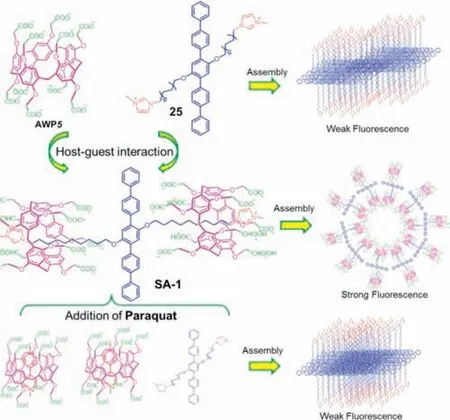
Fig.13.Schematic representation of construction of supra-amphiphile SA-1 and its application in paraquat sensor.Reproduced with permission [35].Copyright 2014,the Royal Society of Chemistry.
Besides paraquat sensing,detection of heavy metal ions which cause severe pollution and toxicity to biological systems is also very important.Many traditional metal ion sensors suffer from the requirements of organic solvents that restrict their environmental applications.Recently, a Fe3+ion sensor based on AWP5 and its host -guest system was reported by Yin and co-workers (Fig.14).Perylenediimide (PDI), a common fluorophore in fluorescent probes, was applied to detect Fe3+ions.The host -guest system was constructed by a water-soluble ammonium modified PDI derivative 43 and AWP5.The self-assembly morphology of the amphiphilic system changed from irregular aggregates to regular blocks along with a fluorescence “turn off”by PET in the presence of AWP5.Notably,by testing the effects of various metal ions,only Fe3+ions caused the fluorescence “turn on”.Further study showed that Fe3+ions had strong interactions with SA-20, and the interdiction of the PET process was the dominant reason for fluorescent recovery.The reversibility of this fluorescence sensor was measured by alternately adding Fe3+ions and competitive chelator Na4P2O7; the sensor showed reversible fluorescent changes [53].The supra-amphiphilic pillararene renders the system simple synthesis and reversibility.Moreover, this Fe3+ion sensor exhibits a specific response to Fe3+ions with a detection limit of 2.13×10-7mol/L, which demonstrates the promising applications of pillar[n]arenes in environmental or biological monitoring [53].
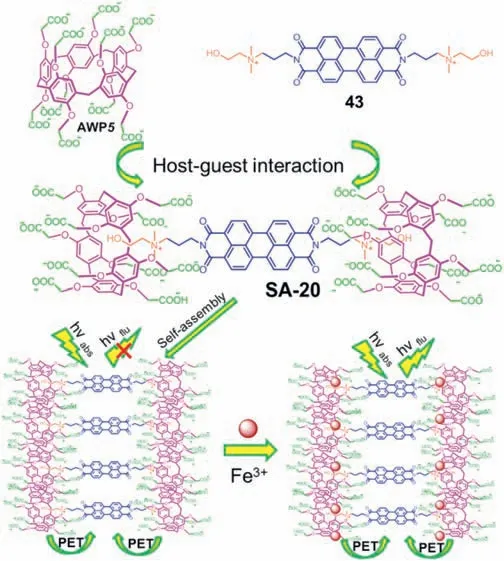
Fig.14.Chemical structures of the AWP5 and guest 43 and a cartoon representation of the Fe3+ ion sensing mechanism.Reproduced with permission [53].Copyright 2017, American Chemical Society.
3.2.2.Controlled drug release and cancer therapy
The dynamic host-guest interaction endows supramolecular amphiphile stimuli-responsive characteristics.For example, Prof.Shi and co-workers constructed a Bola-type supra-amphiphile from AWP6-based recognition motif in water and investigated its application in controlled release [56].As shown in Fig.13, a new host-guest system based on a naphthalene group-modified azobenzene-containing guest (trans-46) and AWP6 was constructed in water.The host-guest complexation between AWP6 and trans-46 could be reversibly controlled by UV light and pH changes.The trans-46 itself self-assembled into nanosheets,while the Bola-type supra-amphiphile(SA-23)based on AWP6 and trans-46 self-assembled into vesicles (Fig.15).Reversible transitions between vesicles and nanosheets were achieved due to the photoresponsiveness of the guest and the pH-responsiveness of the host.In this case,doxorubicin can be encapsulated into the vesicles and then controlled release upon UV irradiation or decreasing pH.
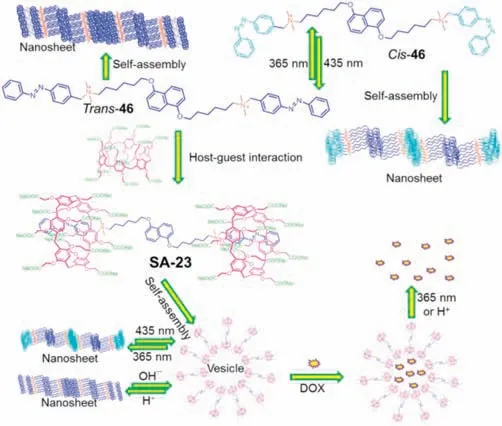
Fig.15.Schematic illustration of construction of SA-23 from host AWP6 and guest 46, and its further application in multi-stimuli responsive controlled DOX release.Reproduced with permission[56].Copyright 2016,the Royal Society of Chemistry.
In 2014, our group synthesized the first cationic water-soluble pillar[6]arene (CWP 6-3) and investigated the complexation between CWP 6-3 and sodium p-hydroxybenzoate derivative(56) in water.The new supramolecular amphiphile SA-33 was easily constructed by mixing CWP 6-3 and 56 in water at the ratio of 1:1.The transformations between solid micelles based on 56 and vesicles based on SA-33 were realized by adjusting the solution pH due to the pH-responsiveness of 56.Then the controlled release of calcein dye molecules from the vesicles was achieved by the collapse of the vesicles upon changing the solution pH to acidity[66].
Supramolecular drug delivery systems for cancer therapy are a feasible approach to enhance the specificity and efficacy of therapeutic drugs.For example, Prof.Fan and co-workers fabricated a multifunctional supramolecular amphiphile (SA-9)based on recognition of AWP5 and 33 efficiently(Fig.16)[43].They found SA-9 can self-assembly into vesicles and these vesicles have good encapsulation capacity for the hydrophilic hypoxia activated prodrug TPZ and rapid TPZ release at tumor locations with acidic microenvironments.Such TPZ-loaded vesicles exhibited remarkable antitumor efficacy under irradiation by a single NIR laser through a combination of the effects of PTT and PDT.Importantly,a hypoxic microenvironment could be obtained efficiently due to continuous oxygen consumption during PDT, which activated the antitumor activity of the loaded TPZ for synergistic enhancement of cancer therapy.Furthermore, such vesicles could enter tumor cells efficiently to realize remarkable drug accumulation.Overall,this work provides an innovative tactic to construct smart DDSs,which could show important advantages in clinical practice.
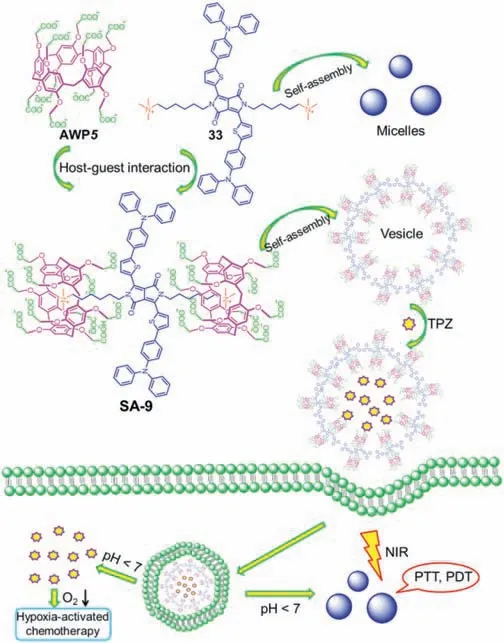
Fig.16.Construction of multifunctional supramolecular vesicles from AWP5 and guest 33 for combination cancer therapy.Reproduced with permission [43].Copyright 2018, the Royal Society of Chemistry.
By modifying a drug molecule onto guest,Dr.Yu and co-workers constructed a therapeutic supramolecular amphiphile (SA-39)based on a NWP5-3&62 host-guest molecular recognition [71].Benefiting from supramolecular formulation, SA-39 self-assembled into stable solid nanoparticles with an average diameter of 152 nm in aqueous solution.In a high GSH environment, the disulfide bond was cleaved, resulting in the fast release of active CPT in cancer cells.CLSM experiments proved that these solid nanoparticles effectively enhanced the CPT uptake.MTT experiments revealed that not only was the efficacy of solid nanoparticles greatly maintained,but also they could perform well in other kinds of cancer cells, demonstrating the role of solid nanoparticles is a broad-spectrum one.The current study supplies a novel supramolecular method for the fabrication of stimuli-responsiveness DDSs,which has great potential for applications in cancer treatment.
Importantly,in 2018,Prof.Wang and co-workers constructed a closed-loop “smart”insulin delivery system with the capability to mimic pancreatic cells for diabetes treatment (Fig.17).This study reports a multiple stimuli-responsive insulin delivery platform based on an explicit supramolecular strategy[55].Self-assembled from a well-designed supramolecular amphiphiles(SA-22)formed by pillar[5]arene (AWP5) and a diphenylboronic acid derivative(45) and loaded with insulin and glucose oxidase, the obtained insulin-GOx-loaded supramolecular vesicles can selectively recognize glucose, accompanied by the structure disruption and efficient release of the entrapped insulin triggered by the high glucose concentration as well as the in situ generated H2O2and acid microenvironment during the GOx-promoted specific oxidation of glucose into gluconic acid.Moreover, such a “smart”supramolecular theranostic nanoplatform is able to function as both a glucose sensor and a controlled insulin delivery actuator.In vivo experiments further demonstrate that this smart supramolecular nano-carrier shows fast response to hyperglycemic circumstances and can effectively regulate the glucose levels in a mouse model of type I diabetes.
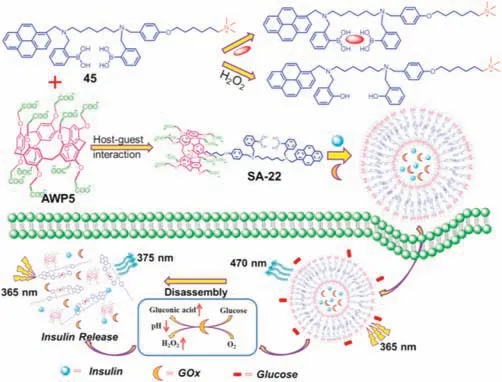
Fig.17.Supramolecular self-assembly of the host-guest complex AWP5 ⊃45 into vesicles and their successful encapsulation of insulin and GOx as well as the efficient insulin release under hyperglycemic state.Reproduced with permission[55].Copyright 2018, John Wiley and Sons.
Then they constructed dual photo-and pH-responsive supramolecular nanocarriers based on AWP6 and azobenzene derivative 30 for intracellular anticancer drug delivery.The resulting SA-6 vesicles can efficiently encapsulate anticancer drug mitoxantrone(MTZ) to achieve MTZ-loaded vesicles, which maintain good stability in a simulated normal physiological environment,whereas in an acid environment similar to that of tumor cells or with external UV irradiation, the encapsulated drug is promptly released [41].More importantly, cytotoxicity assay indicates that such vesicles have good biocompatibility and the MTZ-loaded vesicles exhibit comparable anticancer activity to free MTZ,especially with additional UV stimulus, whereas its cytotoxicity for normal cells was remarkably reduced.Flow cytometric analysis further confirms that the cancer cell death caused by MTZ-loaded vesicles is associated with apoptosis.Therefore, the dual pH- and UV-responsive supramolecular vesicles are a potential platform for controlled release and targeted anticancer drug delivery.
These several pioneering examples pointed out the advantages of pillar[n]arene-based SAs in biochemical applications.The easyto-functionalize characteristic of pillararenes endows the hosts with diversity and multiple merits such as biocompatibility and stimuli-responsiveness.The host -guest interactions benefit the introduction of functional guests, for example, targeting groups,diagnostic/imaging agents,and therapeutics.The reversibility and stimuli-responsiveness of the non-covalent interactions are usually used to control the self-assembly behaviour,which further controls their bio-applications.As reported by Prof.Zhang in 2018,they constructed a mitochondria-targeting supramolecular photosensitizer SA-40 based on NWP 5-3 and 63 for photodynamic therapy [72].Prof.Pei and co-workers fabricated another supramolecular photosensitizer system based on the host -guest complexation SA-25 between AWP6 and 48 for durable photodynamic therapy [58].
3.2.3.Biological imaging
In order to broaden the applications of pillar[n]arene-based supramolecular amphiphiles,Huang et al.reported self-assembled nanoparticles with NIR emission based on AWP5 and a NIR fluorophore for cell imaging (Fig.18) [45].Cyanostilbene derivatives (35) are known to absorb visible light and emit red to NIR fluorescence, and their emission could be enhanced by formation of an aggregated state.Therefore,cyanostilbene derivative 35 with aggregation induced emission (AIE) and NIR emission was modified with a cationic group as a guest of AWP5.The aqueous solution of 35 had nearly no emission, and the aggregated nanoribbons showed a slight fluorescent enhancement.Notably,the formation of the host -guest complex significantly increased the NIR emission, which was explained by host-guest complexation enhanced aggregation.The morphology self-assembled by supra-amphiphilic AWP5/35 was NPs,which showed pH-response due to the precipitation of AWP5 in acid conditions.Considering that the excitation and emission wavelengths exhibited low photodamage to biological samples, these NIR nanoparticles were further used in cell imaging.After incubating with SA-11 nanoparticles,bright red fluorescence was observed in the cytoplasm of Hela and brain microvascular endothelial (bEnd.3) cells.These results indicated the NIR nanoparticles were successfully applied in cell imaging and pillararene-based host -guest complexes could have enormous potential in functional fluorescent materials.
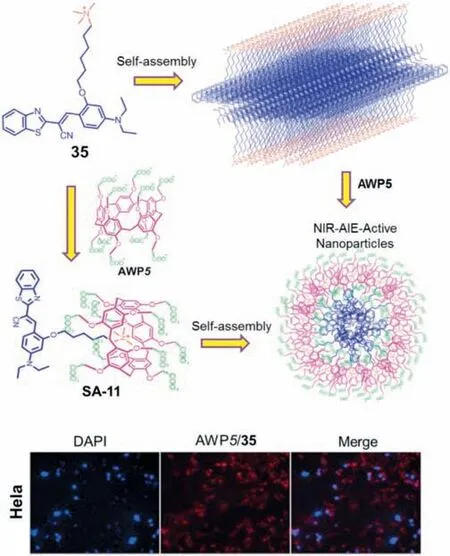
Fig.18.Schematic representation of self-assembly processes of 35 and SA-11 and the CLSM images of HeLa cells demonstrating the cell image capability of the SA-11 supra-amphiphile.Reproduced with permission [45].Copyright 2016, American Chemical Society.
Besides, their group developed a novel supramolecular hybrid material, GO@CWP 6-2@55, integrating GO and a pillar[6]arene based host -guest complex (SA-32) driven by non-covalent interactions [65].By employing the NIR light-mediated photothermal effect of GO,the bicarbonate counterions on the surface of the supramolecular hybrid material were decomposed into CO2nanobubbles upon NIR laser irradiation.The generated CO2nanobubbles acting as “molecular boosters” can be used to enhance the ultrasound and photoacoustic signals,resulting from their small size and excellent tissue permeability.On the other hand, the supramolecular formulation effectively increased the NIR absorption of the resultant supramolecular hybrid material,improving the photothermal effect of GO@SA-32, which was further beneficial to the enhancement of its photoacoustic signal.This supramolecular method provides an exceedingly exquisite strategy to improve the photoacoustic and ultrasound performances of functional hybrid materials by fully taking advantage of supramolecular chemistry, which paves a distinctive way to develop smart nanomaterials for imaging-guided theranostic applications.
3.2.4.Light-harvest and conversion
Light is a clean and renewable energy source.At present,scientists are focus on how to transform and used light energy effectively.With this in mind, Prof.Wang and co-workers fabricated highly efficient artificial light-harvesting systems in aqueous environment based on a facile supramolecular selfassembly strategy (Fig.19) [60].The easily obtained SA-27 supramolecular assembly showed significantly enhanced fluorescence owing to an enhanced AIE effect.After simply mixing SA-27 assembly with hydrophobic fluorescence dye Nile Red or Eosin Y,two artificial light harvesting systems were successfully constructed based on the highly efficient FRET process that takes place from the donor(SA-27 assembly)to the acceptor(Nile Red or Eosin Y).More importantly, both of these two artificial light-harvesting systems showed very high antenna effect(25.4 for SA-17-Nile Red assembly and 28.0 for SA-17-Eosin Y assembly) with high donor/acceptor ratio(up to 150:1 for SA-17-Nile Red system and 200:1 for SA-17-Eosin Y system), which are similar to that of natural lightharvesting system.Therefore, these highly efficient aqueous artificial light-harvesting systems are very important and versatile platform for mimicking photosynthesis.
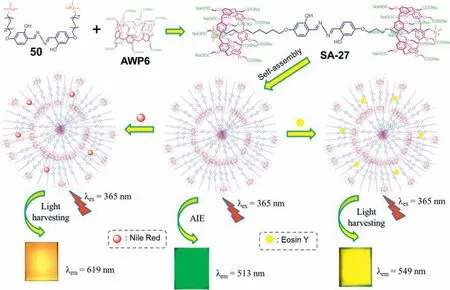
Fig.19.Representation of the self-assembly of AWP6&50-based aqueous light-harvesting systems.Reproduced with permission[60].Copyright 2018,John Wiley and Sons.
4.Summary and outlook
In this review, we have described the preparation, selfassembly properties, and applications of amphiphilic pillar[n]-arenes and supra-amphiphilic pillar[n]arenes.Due to the unique chemical structures of the amphiphilic pillar[n]arenes and supraamphiphilic pillar[n]arenes, they can self-assemble into different type of well-defined morphologies, such as micelles, vesicles,necklace structures, nano-sheets, and nano/micro-tubes.What is more, the dynamic nature of noncovalent interactions endows amphiphilic pillar[n]arenes and supra-amphiphilic pillar[n]arenes with multiple stimuli-responsiveness.For example,the host -guest complexation can be adjusted by guest competition, heating, pH changing and other external stimuli,and the morphologies of selfassemblies or the functions of the systems can be easily tailored.By integrating these advantages,many complex systems with unique properties can be easily prepared.
Although great development have been made in the area of amphiphilic pillar[n]arenes and supra-amphiphilic pillar[n]arenes,there are still some challenges and objectives.First, systematic investigation of the relationship between molecular structures and assembly morphologies, which can help us predict the properties of the assemblies.Second, how to prepare amphiphilic pillar[5]arenes efficiently and how to design and prepare larger cavity amphiphilic pillar[ n]arenes (n >6).Third, the cavities of pillar[n]arenes are well utilized in construction supra-amphiphilic pillar[n]arenes, but they have not been utilized in amphiphilic pillar[n]arenes ’ assemblies.Actually, utilized the host-guest recognition cavity of pillar[n]arenes on the surface of the assemblies can modify functional units on the assemblies and achieve multidimensional and hierarchical morphologies.Last but not least, co-assembly of pillar[n]arene-based amphiphilies can result in better binding affinity and heteromultivalent recognition.Altogether, there is no doubt that the investigations about pillar[n]arene-based amphiphiles have become a rising star in various fields.
Declaration of competing interest
The authors declare that they have no known competing financial interests or personal relationships that could have appeared to influence the work reported in this paper.
Acknowledgments
This work was supported by the National Natural Science Foundation of China (Nos.21801139, 21871227), Natural Science Foundation of Jiangsu Province(No.BK20180942),and the Natural Science Foundation of Nantong University for High-Level Talent(No.03083004).
杂志排行
Chinese Chemical Letters的其它文章
- D-A-D structured selenadiazolesbenzothiadiazole-based near-infrared dye for enhanced photoacoustic imaging and photothermal cancer therapy
- Synthesis and biological evaluation of a lipopeptide-based methamphetamine vaccine
- Nucleic acids induced peptide-based AIE nanoparticles for fast cell imaging
- Titanate nanofibers reduce Kruppel-like factor 2(KLF2)-eNOS pathway in endothelial monolayer: A transcriptomic study
- Drug-induced hierarchical self-assembly of poly(amino acid) for efficient intracellular drug delivery
- Co-delivery of anticancer drugs and cell penetrating peptides for improved cancer therapy
